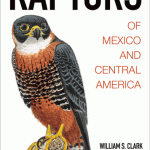Central America
There are about four hundred species of birds we call "raptors" of which most are falcons, hawks, eagles, owls, and so forth. I believe there are about 40 in what is considered the United States (from a person, not a bird, perspective) and many of them are found across much of the US, with the usual breaks across the Rockies, and a certain amount of north-south geography, and varying degrees of migration.
A typical page
There are 69 species of raptors, many overlapping with those in the US, in Mexico (which is part of North America, from a human perspective) and Central America.…
We picked up a used copy of Charles Mann's pop-archeology book 1491: New Revelations of the Americas Before Columbus a while back. I didn't read it at the time, because I was a little afraid that it would be rather polemical in what I think of as the Neil Young mode-- wildly overstating the awesomeness of pre-Columbian cultures, and exaggerating the evil of the European invaders (Neil's recorded some great stuff, but the lyrics to "Cortez the Killer" are pretty dopey). It came up several times recently in discussions elsewhere, though, and seemed like it would make a nice break from the…
Popocatépetl from the ISS on January 23, 2001
It might be (and is likely) just normal behavior for Popocatépetl in Mexico, but the volcano produced six plumes over the last 24 hours, according to a report out of Mexico City (in spanish). Officials from El Centro Nacional de Prevención de Desastres (The National Center for the Prevention of Disasters - Cenapred) say that the plumes appear to be mostly water vapor and other volcanic gases, but remind people living near the volcano to be vigilant.
Popocatépetl is only 70 km from Mexico City, so any major eruption from the volcano could…
Eruptions and earthquakes go hand-in-hand a lot of the time. It only makes sense as magma needs to move under the crust, causing movement (i.e., earthquakes). Additionally, any sort of explosions caused by the release of volatiles might cause earthquakes or even the collapse of an edifice (which in turn, shakes the earth).
So, it is not surprising that the current eruption at San Cristobal in Nicaragua has produced earthquakes. The reports are relatively lacking in details, but San Cristobal is a typical Central America stratovolcano that produces frequent Strombolian style eruptions, which…
Some news of a series of small eruptions at San Cristobal in Nicaragua. Ash from the small explosions drifted to a town near the volcano, however officials for Ineter in Nicaragua say that there is little chance of a large eruption.
San Cristobal is one of the seven active volcanoes in Nicaragua. It has a long record of small eruptions, with at least one every year in the 21st century (and beyond). The largest eruption in recent times was in 1999 that produced lahars and an explosive eruptions (landing us at VEI 2).
Things have quieted down on the volcano-news front lately. I did catch a report that Fuego (Guatemala) is having small explosions (stombolian eruptions; link in Spanish), producing small (100s m-tall) ash columns along with some throwing incandescent blocks 30-50 meters from the vent. Just the typical noises expected at an active volcano. In the meantime, you can check out the volcanic hazards information that the Guatemalan survey (INSIVUMEH) has posted on their website. I'm always a fan of a country trying to educate their citizens of the real dangers of volcanoes and how to prepare.
Today, I saw a report that a dome on Arenal in Costa Rica had collapsed last Friday (report in Spanish, but good picture of the event), producing a block & ash flow that left a 800-meter scar on the volcano's flank. No one was injured during the avalanche, but tourists were evacuated as a precaution. There have been minor rock fall related to the andesite lava that has been erupting over the last year, but apparently this is the first major avalanche.
This shows the fine line between an effusive (lava flow dominated) eruption and explosive (pyroclastic dominated) eruption. Although this…
I've been trying to find information to post this week, but not much out their in the press this week.
I did like this article on the close relationship between Salvadoran coffee growers and Santa Ana/Ilamatepec Volcano. After being pressed into an emergency lecture yesterday here about the interactions between humans and volcanoes, this is case in point that a mere 3 years after an eruption helped wipe out their crops, coffee growers are back to planting near Santa Ana's crater. It is hard not to when the soils near the volcano are so fertile. You can see in the picture (above) how lush the…
